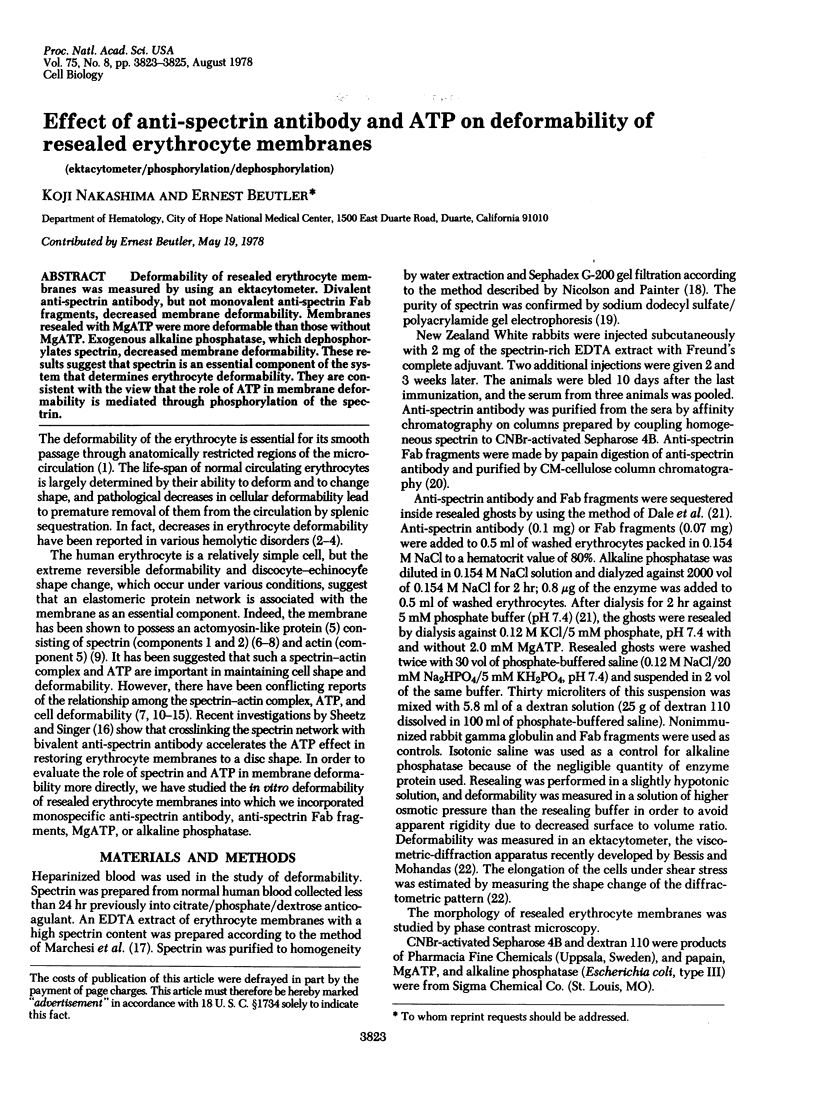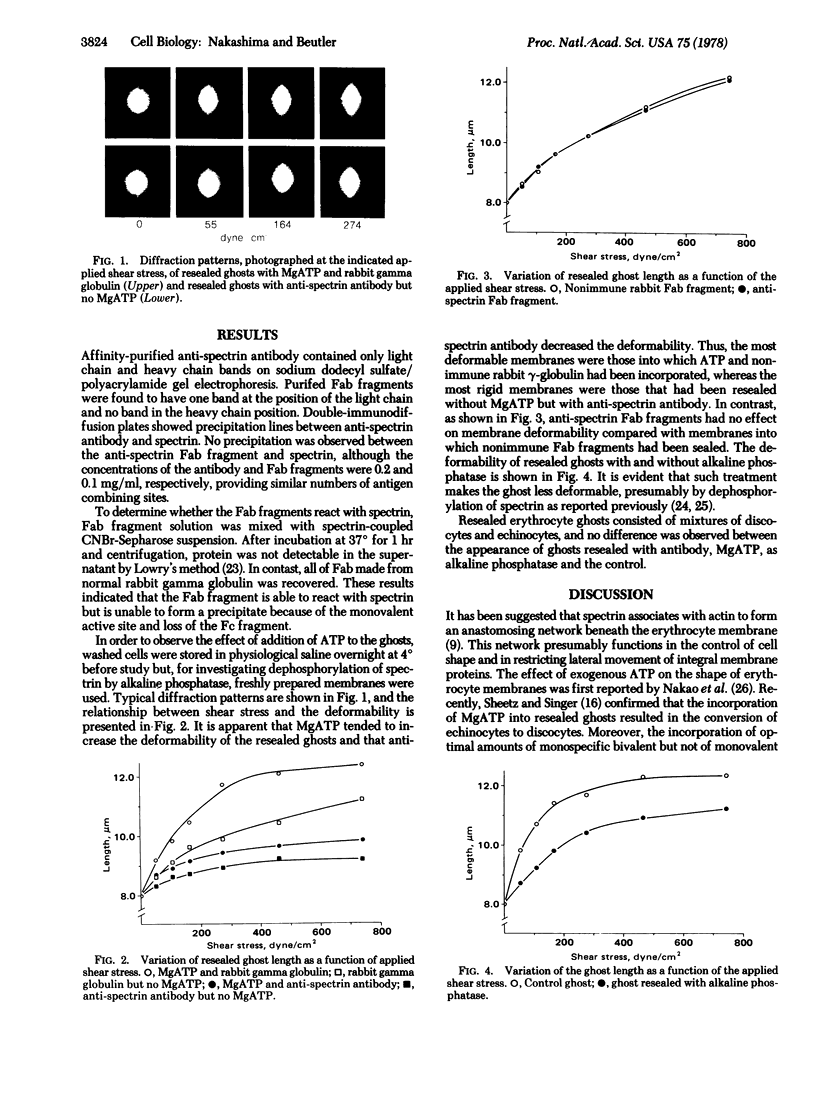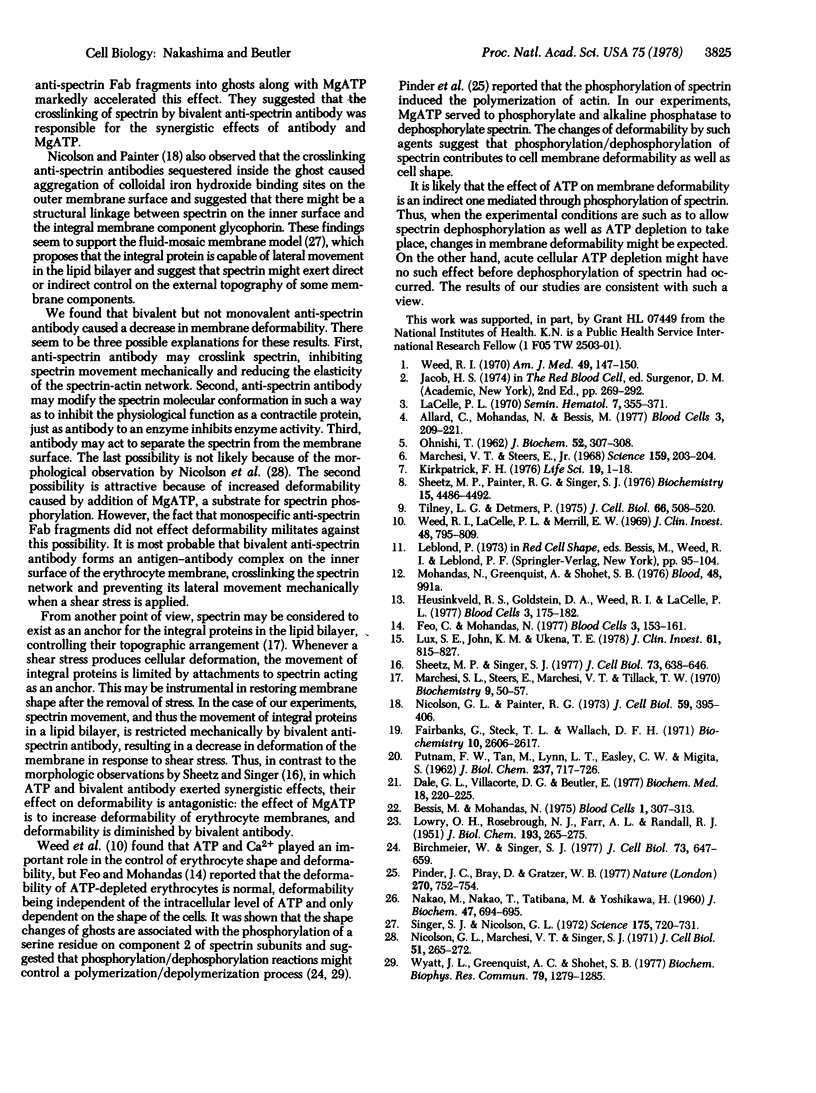Abstract
Deformability of resealed erythrocyte membranes was measured by using an ektacytometer. Divalent anti-spectrin antibody, but not monovalent anti-spectrin Fab fragments, decreased membrane deformability. Membranes resealed with MgATP were more deformable than those without MgATP. Exogenous alkaline phosphatase, which dephosphorylates spectrin, decreased membrane deformability. These results suggest that spectrin is an essential component of the system that determines erythrocyte deformability. They are consistent with the view that the role of ATP in membrane deformability is mediated through phosphorylation of the spectrin.
Full text
PDF


Images in this article
Selected References
These references are in PubMed. This may not be the complete list of references from this article.
- Birchmeier W., Singer S. J. On the mechanism of ATP-induced shape changes in human erythrocyte membranes. II. The role of ATP. J Cell Biol. 1977 Jun;73(3):647–659. doi: 10.1083/jcb.73.3.647. [DOI] [PMC free article] [PubMed] [Google Scholar]
- Dale G. L., Villacorte D. G., Beutler E. High-yield entrapment of proteins into erythrocytes. Biochem Med. 1977 Oct;18(2):220–225. doi: 10.1016/0006-2944(77)90093-x. [DOI] [PubMed] [Google Scholar]
- Fairbanks G., Steck T. L., Wallach D. F. Electrophoretic analysis of the major polypeptides of the human erythrocyte membrane. Biochemistry. 1971 Jun 22;10(13):2606–2617. doi: 10.1021/bi00789a030. [DOI] [PubMed] [Google Scholar]
- Kirkpatrick F. Spectrin: current understanding of its physical, biochemical, and functional properties. Life Sci. 1976 Jul 1;19(1):1–17. doi: 10.1016/0024-3205(76)90368-4. [DOI] [PubMed] [Google Scholar]
- LOWRY O. H., ROSEBROUGH N. J., FARR A. L., RANDALL R. J. Protein measurement with the Folin phenol reagent. J Biol Chem. 1951 Nov;193(1):265–275. [PubMed] [Google Scholar]
- LaCelle P. L. Alteration of membrane deformability in hemolytic anemias. Semin Hematol. 1970 Oct;7(4):355–371. [PubMed] [Google Scholar]
- Lux S. E., John K. M., Ukena T. E. Diminished spectrin extraction from ATP-depleted human erythrocytes. Evidence relating spectrin to changes in erythrocyte shape and deformability. J Clin Invest. 1978 Mar;61(3):815–827. doi: 10.1172/JCI108996. [DOI] [PMC free article] [PubMed] [Google Scholar]
- Marchesi S. L., Steers E., Marchesi V. T., Tillack T. W. Physical and chemical properties of a protein isolated from red cell membranes. Biochemistry. 1970 Jan 6;9(1):50–57. doi: 10.1021/bi00803a007. [DOI] [PubMed] [Google Scholar]
- Marchesi V. T., Steers E., Jr Selective solubilization of a protein component of the red cell membrane. Science. 1968 Jan 12;159(3811):203–204. doi: 10.1126/science.159.3811.203. [DOI] [PubMed] [Google Scholar]
- Nicolson G. L., Marchesi V. T., Singer S. J. The localization of spectrin on the inner surface of human red blood cell membranes by ferritin-conjugated antibodies. J Cell Biol. 1971 Oct;51(1):265–272. doi: 10.1083/jcb.51.1.265. [DOI] [PMC free article] [PubMed] [Google Scholar]
- Nicolson G. L., Painter R. G. Anionic sites of human erythrocyte membranes. II. Antispectrin-induced transmembrane aggregation of the binding sites for positively charged colloidal particles. J Cell Biol. 1973 Nov;59(2 Pt 1):395–406. doi: 10.1083/jcb.59.2.395. [DOI] [PMC free article] [PubMed] [Google Scholar]
- OHNISHI T. Extraction of actin- and myosin-like proteins from erythrocyte membrane. J Biochem. 1962 Oct;52:307–308. doi: 10.1093/oxfordjournals.jbchem.a127620. [DOI] [PubMed] [Google Scholar]
- PUTNAM F. W., TAN M., LYNN L. T., EASLEY C. W., MIGITA S. The cleavage of rabbit gamma-globulin by papain. J Biol Chem. 1962 Mar;237:717–726. [PubMed] [Google Scholar]
- Pinder J. C., Bray D., Gratzer W. B. Control of interaction of spectrin and actin by phosphorylation. Nature. 1977 Dec 22;270(5639):752–754. doi: 10.1038/270752a0. [DOI] [PubMed] [Google Scholar]
- Sheetz M. P., Painter R. G., Singer S. J. Relationships of the spectrin complex of human erythrocyte membranes to the actomyosins of muscle cells. Biochemistry. 1976 Oct 5;15(20):4486–4492. doi: 10.1021/bi00665a024. [DOI] [PubMed] [Google Scholar]
- Sheetz M. P., Singer S. J. On the mechanism of ATP-induced shape changes in human erythrocyte membranes. I. The role of the spectrin complex. J Cell Biol. 1977 Jun;73(3):638–646. doi: 10.1083/jcb.73.3.638. [DOI] [PMC free article] [PubMed] [Google Scholar]
- Singer S. J., Nicolson G. L. The fluid mosaic model of the structure of cell membranes. Science. 1972 Feb 18;175(4023):720–731. doi: 10.1126/science.175.4023.720. [DOI] [PubMed] [Google Scholar]
- Tilney L. G., Detmers P. Actin in erythrocyte ghosts and its association with spectrin. Evidence for a nonfilamentous form of these two molecules in situ. J Cell Biol. 1975 Sep;66(3):508–520. doi: 10.1083/jcb.66.3.508. [DOI] [PMC free article] [PubMed] [Google Scholar]
- Weed R. I., LaCelle P. L., Merrill E. W. Metabolic dependence of red cell deformability. J Clin Invest. 1969 May;48(5):795–809. doi: 10.1172/JCI106038. [DOI] [PMC free article] [PubMed] [Google Scholar]
- Weed R. I. The importance of erythrocyte deformability. Am J Med. 1970 Aug;49(2):147–150. doi: 10.1016/s0002-9343(70)80069-9. [DOI] [PubMed] [Google Scholar]
- Wyatt J. L., Greenquist A. C., Shohet S. B. Analyses of phosphorylated tryptic peptide of spectrin from human erythrocyte membrane. Biochem Biophys Res Commun. 1977 Dec 21;79(4):1279–1285. doi: 10.1016/0006-291x(77)91144-5. [DOI] [PubMed] [Google Scholar]



